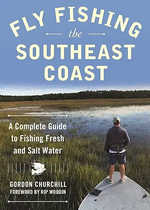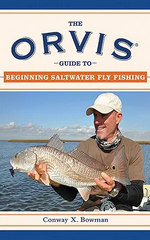How to Shop for a Rod
The time has come to go buy a rod. You have done some homework by reading reviews, checking YouTube rod reviews done by various large fly shops, checked with friends and, whenever possible, actually gotten to cast a rod identical or at similar to what you want to get. You have narrowed down the price range you want to consider and gotten several members of the Cape Fear Flyfishers to join you at the store.
There, in all their glory, are a lot of rods. You go through them, looking at labels as to size and cost of the rod. One or more look interesting.
Now what? You take one out of the rack and, being very careful not to crash it into the ceiling or light fixtures, you begin to wave it back and forth. We all do this. It looks cool and we have seen lots of people do it over the years. We’re not quite sure that we know what we’re trying to figure out but we will do it anyway.
The fact is, this “tradition” doesn’t tell us a whole lot about the rod, other than it, like every other fly rod, goes east and west well. It has the advantage of getting the attention of the sales staff who come to help us out and maybe, just maybe, to protect their inventory from us.
What we can learn when we pick up that rod and waving it around is its action. But for it to tell us that, we need to be very intentional in our waving. We want to see how far it will bend when we make a cast. Will it bend almost to the handle? Soft or slow action. Easy to cast, particularly at relatively short distances. Will it bend only about half-way down the rod? Medium action. Still fairly easy to cast but we can expect a little more distance when we need it. Will it bend only in the top section and maybe a touch into the next section? Fast action. Harder to cast well but in the hands of a good caster it will work best in the wind and if we’re good, Lefty Kreh’s 100’ cast is at least a possibility after lots of practice. But this is not the rod we need on mountain streams. It’s at home in the marsh casting for reds who are pretty spooky in shallow water, in the ocean when we’re trying to send a fly to a school of false Albacore before they dive and turn off or on a windy day when we really need to punch the fly into the wind. That’s what we learn by holding the rod at about a 60º angle from the floor and accelerate firmly to a complete stop at about 45-50º from the floor.
An added benefit is the salespeople will come over with a more positive attitude that here is someone who knows enough to test the rod correctly. So, you might get treated with a bit more respect, even if you don’t have a clue. But at least you know how to check out a fly rod in the fly shop. You can even play a bit dumb and ask the salesperson to talk about the virtues of the various actions and what his take is on what would be the best rod for you to consider. Just tell him or her that you have been away from fly fishing and haven’t bought a new rod in ages (which is true even if you have never bought a new fly rod). I, after all, am an expert in the “White lie.”
Meanwhile, those of us from the Club you invited along to help you decide are trying our best not to break out giggling. Enjoy our misery. And enjoy your new rod!
Shopping for a Reel
As for the reel, it depends if you are getting something light for trout and panfish or something a bit heavier for saltwater. As you have picked up from reading previous lessons, you know that for most freshwater fishing, the drag for a reel is nice but not essential. So, almost any reel will work. Just know (as you do already if you have read the other essays), machined reels cost more, weigh less and are tougher so they won’t bend or crack as readily if dropped (or make that when) dropped. In this is regard, you have read numerous authors cite the Orvis Battenkill Disc as a remarkable and relatively inexpensive machined reel. If have a lot of them and stand behind the older versions. I haven’t bought a new one yet. Know that Orvis makes the Orvis Battenkill reel that looks pretty much identical to the OB Disc reel but does not have a disc drag. Don’t be disappointed and make sure you are getting what you want. Also, if you can possibly afford it, get at least one extra spool for every reel you buy. This way you can have two different lines for your outfit or have a backup if you happen to mess up the original spool. But for freshwater, you can be guided more by price, though I must put in a plug for the Lamson Liquid and the Redington Behemoth. I have the Liquid and know people with the Redingtons.
Make sure the reel you buy has room not only for the fly line your buy and enough backing for the fish you hope to catch. All of my saltwater reels have at least 200 yards of Dacron line as backing.
Speaking of backing, you can get Dacron, gel or braid. They all work. I am a fan of Dacron for three main reasons. First, it is inexpensive. Second, it lasts forever. Three, it is thick enough and “rough” enough that it doesn’t dig into itself when under pressure (such as from a big fish) so it peels off the spool smoothly instead of creating a bad knot and screwing up everything. Of course, with some gels and almost all braid, you can get a lot more backing on your reel. But 200 yards of Dacron will work for most of the fish I intend to catch. If I’m going after huge fish, I will have a huge reel that will hold even more backing.
Buying Fly Line
You can buy fly line for $20 a spool. Mostly if it is overruns from good companies, or so I was told. But I didn’t buy it to fish it but to use it for practice. The only time I have ever seen such a deal was at the Fly Fishing Show in Winston-Salem several years ago. The following year the Show moved to Atlanta. Quite a deal.
Years ago, I served a congregation in rural/small town South Carolina. We had a young couple who ran a men’s store in a near-by small town. In the early 1970s, he was selling suits in the $70-$100 range at a time when a Hart, Shaffner & Marx (a very reputable mid-range suit) was in the $225-$275 range, by and large. I felt an obligation to give this young man and his bride who grew up in the congregation some business. So I did. It bought several suits and wore them. But after a year, they were pretty well shot. Like, falling apart shot. My Hart Shaffner & Marx suits bought previously were still in good shape and I wore them for 10-15 years when they suddenly started shrinking (of something like that). My Dad, a physics professor, had one Hickey Freeman suit he wore for 40+ years. To be honest, he didn’t wear it very often- many Sundays and for weddings and some funerals. But it looked as good on him the last time he wore it as it did the first time.
In other words, you may not get what you pay for but you seldom get more than you pay for. I have gotten $35 line and it wound up on my “cast on the gravel” reels for practice. But I still have some of the $80 line I bought 10 years ago. Lines have gone up in price and I was able to order several of my favorite lines before they were discontinued. Some of the real fancy lines these days are over $100. No doubt I will buy some sometime.
The main point is to take care of them- see Maintenance of Line. They will last a lot longer and cast a lot better. Keep them clean and out of sunlight. Also, stretch them before each use and clean them after every use.
Inexpensive lines have their place but I would advise sticking to the good stuff for fishing. They will cast so much better and last for years with proper care. I tend to like Orvis line because I am familiar with it. But I have a lot of Rio and SA (Scientific Angler). I need to try Courtland but I have some Teeny specialty line.



